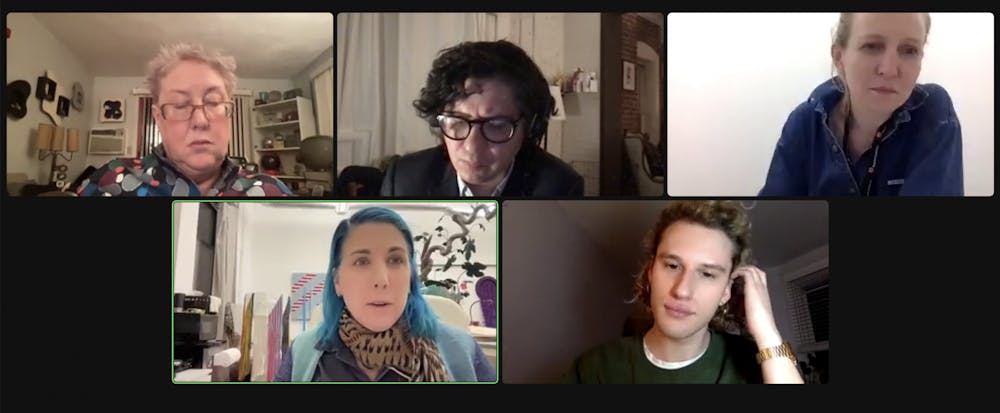On Wednesday, the Pembroke Center for Teaching and Research on Women held a virtual panel discussion titled “Over the Rainbow: (Re)Considering the Pride Flag(s).” The event was hosted by the Center’s LGBTQIA+ Thinking initiative which, according to its website, is “devoted to the active production of knowledge generated from and about sexual minorities.”
The event was led by Lynne Joyrich, director of the LGBTQIA+ Thinking initiative and professor of modern culture and media, and included four panelists: Liz Collins, a multimedia artist; Michelle Millar Fisher, curator of contemporary decorative arts at the Museum of Fine Arts in Boston; Alex Verman Green, writer and law student; and Ivan Ramos, assistant professor of theater arts and performance studies.
The purpose of the discussion, according to the event page, was to explore the evolution of the pride flag from a symbol of gay pride to its current symolization of “a broader, global LGBTQIA+ coalition.”
The discussion began with opening remarks by Leela Gandhi, director of the Pembroke Center, and Joyrich. In reference to the name of the event, Joyrich asked, “Are we now over the rainbow in the sense that we are beyond” pride flags, or does the flag still promise new possibilities for the LGBTQIA+ community?
Fisher kicked off the event with her presentation, “Collecting Pride Flags.” She discussed the Museum of Modern Art’s acquisition of the original pride flag, created by Gilbert Baker in 1978, as part of the museum’s modern contemporary design collection. The collection brought in symbols and icons of the time, including the pride flag.
The museum hung the flag June 26, 2015, the day the Supreme Court legalized same-sex marriage, Fisher said. Referencing a photo from the day, she said that “it was one of the moments actually working as a museum curator that it felt as if you could do something that was useful in the world.”
Fisher also wrote a children’s book published by MoMA centered on the design of the pride flag, she added.
We “wanted to create something that would be a … longer-lasting part of this conversation around the design,” Fisher said.
After Fisher’s presentation, Green discussed their article on the pride flag’s recent redesign and its evolving nature, which was featured in The Atlantic last year. The article discussed the fact that Intersex Equality UK debuted a new design of the flag last year which included the intersex symbol.
“I had the opportunity to talk to several individuals who had their own complicated relationships with the pride flag,” they said. Green expressed “critiques of visibility” in relation to Pride. They referenced how several companies change their logos to the flag during Pride Month as a form of inclusion. Green added that while some may be quick to view this behavior as evidence that these companies “don’t care about gay people,” that sentiment ignores the larger issue of exploitation by corporations, specifically in the Global South.
“To limit our analysis of the authenticity or inauthenticity of certain gestures … inadvertently reifies the idea of an LGBTQ community that exists independently to its relationship to capitalism,” they said. “We risk invisibilizing the invisible hand of the market by framing the problem only in terms of what these brands can do” for the LGBTQ+ community, they added.
After Green’s remarks, Collins discussed her performance art installation project called Knitting Nation. Founded in 2005, the first phase of the project was the knitting of an American flag in 2005 at Governor’s Island.
Collins read an excerpt about her project from Catherine Lord’s book “Art and Queer Culture,” which said that Collins “deploys knitting machine site-specific installation, performance and a small army of collaborators to manufacture comments on the interaction of humans and machines.”
Phase four of her project focused on the reproduction of a pride flag. She employed the Providence community — including students at RISD, where she was previously a faculty member — and created a flag at Waterplace Park in Providence.
“The Knitting Nation project was extremely generative for me,” Collins said, adding that she has now completed fifteen iterations of the project.
The final presenter was Ramos, who played a scene from a Pride event in the “Sex and the City” reboot “And Just Like That.” The clip shows Miranda (Cynthia Nixon) dodging her son and his girlfriend at an event where her nonbinary partner, Che Diaz (Sara Ramirez), is speaking, as she had not yet come out to her family as queer.
“I couldn’t help but feel held by the fact that whenever I find myself surrounded by such a cheery spirit of Pride and its flags, I often feel like running away in horror,” Ramos said.
Diaz “allowed us to recognize the narcissist part of us that wants to embrace the possibility of being proud and boisterous, free from shame,” he said.
The next LGBTQIA+ Thinking event is a screening of experimental shorts titled “Queer Spaces and Places” in the Granoff Center March 21 at 5 p.m.
Kaitlyn Torres was the senior editor of community for The Brown Daily Herald's 133rd Editorial Board. She previously covered diversity as a University News section editor. In her free time, Kaitlyn enjoys listening to The Arctic Monkeys and going on archaeological digs.





